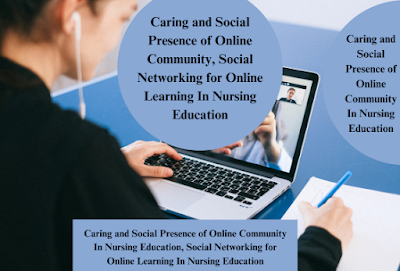The Caring and Social Presence of Online Community Social Networking for Online Learning In Nursing Education. This clarity contributes to respect for intellectual property, promotes collaboration, and protects individuals from potential legal issues.
The Caring and Social Presence of Online Community Social Networking for Online Learning In Nursing Education
Online community networks, when used effectively, can enhance the social and caring presence of online nursing education, fostering deeper engagement and a sense of belonging. By utilizing these platforms, educators can create environments that enable meaningful interactions, promote collaborative learning, and provide students with a sense of community and connection—all critical factors for a positive learning experience.
In the context of online nursing education, understanding content ownership is critical to fostering a strong learning community. Content created by students, faculty, or institutions should be clearly defined in terms of copyright and usage rights to promote ethical and productive participation.
Importance of Caring and Social Presence
Palloff and Pratt (1999) emphasize that certain elements are crucial for building effective online learning communities: honesty, responsiveness, relevance, respect, openness, and empowerment. To foster meaningful participation, students need to expect honest and respectful feedback, prompt responses, and relevant discussions tied to real-life scenarios. It’s also important for students to feel empowered as self-directed learners and free to express their thoughts without fearing negative repercussions, such as lower grades. Faculty must create a nurturing environment that promotes caring.
Strategies for Online Caring
In traditional classrooms, caring is often communicated through facial expressions and body language. However, online settings require different approaches. Sitzman and Leners (2006) discovered that students perceive a caring environment through frequent feedback, active participation, and faculty expressions of concern. Sitzman (2010) further noted that students value clarity in expectations, timely responses, empathy from faculty, and a high level of engagement.
In a subsequent study, Leners and Sitzman (2006) found that students appreciated personal connections with faculty and peers, along with affirmation and encouragement. Additionally, Brownrigg (2005) and Patillo (2007) highlight the need for social presence—an awareness of others in the class—and reducing transactional distance to improve motivation and engagement.
Enhancing Social Presence and Reducing Transactional Distance
To bridge the gap and enhance social presence, strategies include increasing dialogue and interaction, establishing small discussion groups, using web conferencing software (e.g., webinars), and assigning collaborative projects. Other effective methods involve utilizing polling features, increasing faculty contact through various communication technologies, and using emoticons cautiously to convey emotions.
Utilizing Social Networking Tools
Social networking tools like Facebook, YouTube, Twitter, wikis, and blogs can enhance community-building in online courses. These platforms, already familiar to students, facilitate information sharing, collaborative work, and professional development.
Facebook: Students can create pages to introduce themselves, share notes, and work on projects. Some faculty even use Facebook pages for course announcements and assignments.
Twitter: This platform allows users to post brief messages (tweets) to share updates, challenge questions, and information from conferences. Faculty can use Twitter for real-time class interactions.
Blogs: Blogs promote collaboration and reflective thinking. They can serve as journals, platforms for discussing controversial topics, and tools for focus groups and sharing examples.
Wikis: Wikis facilitate group work by allowing collaborative editing of documents. They can be used for group reports, community assessments, journal clubs, and “grand rounds” where students contribute to care plans.
Professional Networking Sites: LinkedIn and similar platforms help students establish professional contacts, explore job opportunities, and engage in professional development.
Guidelines for Effective Use
When integrating social networking tools into courses, it’s crucial to:
- Define clear instructional purposes and measurable outcomes.
- Restrict communication to community members with appropriate safeguards.
- Adhere to privacy policies and respect diversity.
- Ensure professional behavior and adherence to course norms.
By implementing these strategies and tools thoughtfully, nursing education can benefit from enhanced community engagement and effective online learning experiences.
Read More:
https://nurseseducator.com/didactic-and-dialectic-teaching-rationale-for-team-based-learning/
https://nurseseducator.com/high-fidelity-simulation-use-in-nursing-education/
First NCLEX Exam Center In Pakistan From Lahore (Mall of Lahore) to the Global Nursing
Categories of Journals: W, X, Y and Z Category Journal In Nursing Education
AI in Healthcare Content Creation: A Double-Edged Sword and Scary
Social Links:
https://www.facebook.com/nurseseducator/
https://www.instagram.com/nurseseducator/
https://www.pinterest.com/NursesEducator/
https://www.linkedin.com/in/nurseseducator/
https://www.researchgate.net/profile/Afza-Lal-Din
https://scholar.google.com/citations?hl=en&user=F0XY9vQAAAAJ

The article on the [url=https://www.leoweekly.com/cannabis/the-best-cbd-gummies-for-pain-bestsellers-2024-16702836 ]the best CBD Gummies for Pain[/url] was incredibly helpful for navigating the all the way array of products available. It provided elaborate reviews and comparisons, highlighting factors like potency, ingredients, and character feedback. The grouping of pros and cons looking for each product was amazingly utilitarian in making conversant with choices. Whether you’re a young consumer or looking to switch brands, this article offers valuable insights to teach your CBD/THC gummy selection.
Точно актуальные новости индустрии.
Важные новости самых влиятельных подуимов.
Модные дома, лейблы, haute couture.
Свежее место для модных хайпбистов.
https://sochi.rftimes.ru/news/2024-05-20-poslednie-dostizheniya-gerontologii-i-somnologii-na-konferentsii-v-roza-hutor
I am really impressed along with your writing talents as smartly as with the format for your weblog. Is this a paid topic or did you customize it yourself? Either way stay up the nice quality writing, it’s rare to see a nice blog like this one today!